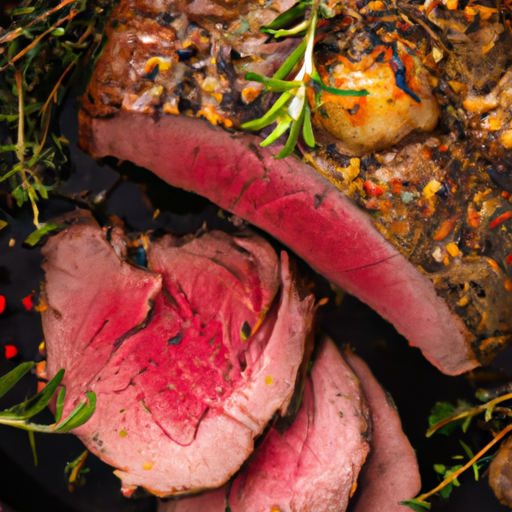Exploring the Delicious Beef Shoulder Roast: A Versatile Cut for Savory Delights
If you’re a fan of tender and flavorful beef, then the beef shoulder roast is definitely worth getting excited about. Often overlooked, this versatile cut offers a plethora of culinary possibilities that will leave your taste buds singing with delight. In this blog post, we’ll dive into the world of the beef shoulder roast, discovering its taste, common uses, nutritional value, and even some interesting historical tidbits.
Taste and Texture
Beef shoulder roast, also known as chuck roast, is a gem in the world of meats due to its rich and robust taste. This cut is marbled with fat, which lends it a remarkable tenderness and juiciness when cooked properly. Its inherent beefy flavor intensifies during cooking, making it an excellent choice for hearty and comforting dishes.
The texture of the shoulder roast is another reason it’s cherished among meat lovers. When slow-cooked, the meat becomes fork-tender, allowing it to effortlessly melt in your mouth. Its juicy and succulent nature sets the stage for endless possibilities in the kitchen.
Common Uses in Cooking
One of the greatest assets of the beef shoulder roast is its versatility in the kitchen. Its ability to adapt to various cooking methods and recipes makes it a go-to choice for both family dinners and dinner parties.
Here are some popular ways to prepare and enjoy this cut:
Pot Roast: Slow cooking the beef shoulder roast with vegetables and aromatic herbs in a pot or a slow cooker creates a mouthwatering, tender roast that practically falls apart with each bite.
Braises and Stews: The beef shoulder roast thrives when cooked low and slow in a flavorful broth or sauce. Its marbling ensures the meat stays moist and tender while absorbing the surrounding flavors to create irresistible stews and braises.
Shredded Beef: The beef shoulder roast is just begging to be shredded. Whether for juicy tacos, sandwiches, or barbecue recipes, slow-cooked shredded beef makes for an incredibly versatile and scrumptious filling.
Steaks: While the shoulder roast isn’t typically the go-to cut for steaks, it can surprise you with its tenderness when cooked to medium-rare or medium. Slicing it thinly against the grain maximizes its tenderness and enhances the overall eating experience.
Nutritional Value
Besides its incredible taste and culinary adaptability, the beef shoulder roast also packs a nutritional punch. It’s a fantastic source of protein, supplying necessary amino acids for building and repairing tissues in our bodies. Additionally, it contains essential minerals like iron, zinc, and B vitamins, contributing to overall well-being.
However, it’s important to note that beef shoulder roast does have a higher fat content compared to leaner cuts. This can be advantageous for those following a high-fat or keto diet, but moderate consumption is recommended for individuals concerned about their fat intake.
History and Fun Facts
The beef shoulder roast has a long history, deeply ingrained in the traditions of comfort food and family gatherings. In the past, tougher cuts of meat like the shoulder roast were often used due to their affordability. Slow-cooking methods were employed to transform these economical cuts into tender and flavorful creations.
Interestingly, in the United States, the beef shoulder roast gained popularity during World War II when shortages and rationing encouraged home cooks to find creative ways to make the most of available ingredients.
Today, the beef shoulder roast remains a beloved staple in many cuisines and households around the world, offering both comfort and sophistication with its incredible taste.
Whether you’re simmering it to perfection for a cozy dinner or crafting mouthwatering shredded beef tacos, the beef shoulder roast continues to inspire culinary enthusiasts with its ability to satisfy hungry hearts and palates.
So next time you visit your local butcher or browse the meat aisles, don’t overlook this underrated cut. Embrace the beef shoulder roast and unlock a world of flavors waiting to be explored!
Beef Shoulder Roast
Origin: Beef shoulder roast is a versatile cut of meat that comes from the shoulder area of a cow. It is commonly known as chuck roast or shoulder clod.
Common Uses: Beef shoulder roast is often used for slow cooking or braising, as it contains a good amount of connective tissue that breaks down during long, moist cooking methods, resulting in tender and flavorful meat. It is commonly used to make pot roast, beef stews, pulled beef sandwiches, and barbecued beef.
Nutritional Benefits: Beef shoulder roast is a good source of high-quality protein, supplying essential amino acids necessary for building and repairing body tissues. It also contains various vitamins and minerals, including iron, zinc, vitamin B12, and niacin. However, it is important to note that beef shoulder roast can be relatively high in fat, so choosing lean cuts or trimming excess fat before cooking can help reduce its overall fat content.
Unique Properties: The beef shoulder roast contains different muscles, including the chuck eye, the clod heart, and the shoulder tender. Each muscle has its own texture and flavor profile, making different parts of the roast suitable for various culinary applications. Additionally, the connective tissue in the shoulder roast breaks down during slow cooking, resulting in a rich and gelatinous texture.
Historical Significance: The chuck roast, which includes the shoulder clod, became a popular cut of meat during the Great Depression in the United States. Being an economical cut, it was often used in hearty and economical dishes that could feed large families and stretch a small budget. Today, beef shoulder roast remains a beloved choice for its rich flavor and versatility in various cuisines around the world.




Use the share button below if you liked it.
It makes me smile, when I see it.